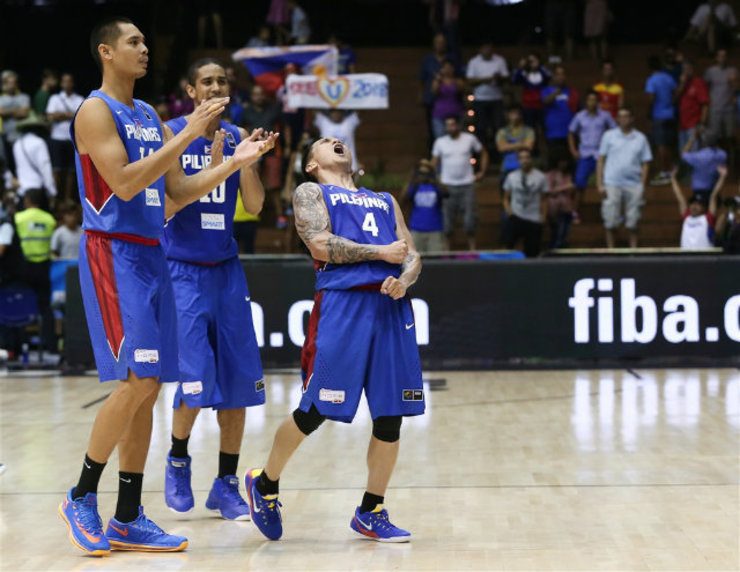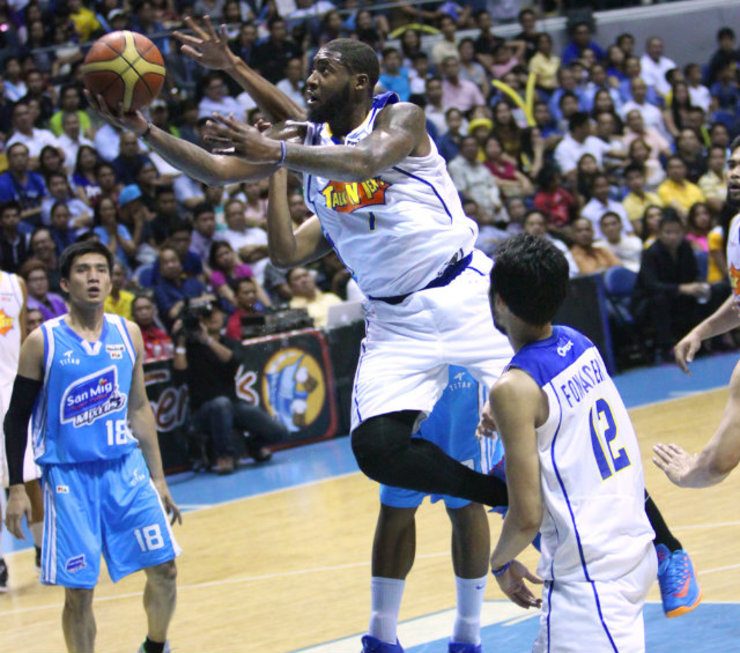SUMMARY
This is AI generated summarization, which may have errors. For context, always refer to the full article.

I’ve long held the belief that in order for anybody to improve at his or her craft, he or she, inevitably, must be exposed to other people who are just as good or even better at that particular craft.
In a regular professional setting, this can mean going to conferences, training seminars, or apprenticeships on foreign soil or inviting world-class individuals to come over and give talks or facilitate skill-acquisition sessions.
In the sports setting, however, this almost always means competing against not just the best in one’s school, one’s neighborhood, one’s city, or even one’s country, but going a step further and measuring one’s capacities against the best and brightest of the continent, if not the world.
In the context of the Philippines, this action results in two outcomes – our athletes get to learn from the best, and our athletes get to show the world how Filipinos play.
This is the reason Gilas Pilipinas’ participation in the 2014 FIBA World Cup was nothing less than a gift. Once one gets past the collapses, the losses, the endgame turnovers, and the missed shots, it should be natural to look at the experience as a building block for the future.
Yes, ultra-veterans like Jimmy Alapag, Ranidel De Ocampo, and Gary David will almost definitely no longer be spry enough to play in the next World Cup (2019 in… Manila?), but for young’ uns like June Mar Fajardo and Paul Lee (both of whom should be favorites to make the 2019 team along with Japeth Aguilar, Andray Blatche, and maybe Jayson Castro, injuries notwithstanding), #Spain2014 offered many lessons that would have been practically impossible to learn in local competition.
This is one reason explaining my contention that, for Philippine basketball’s competitive level to really rise, we must open our game, our brand of hoops, to the rest of the world. Scour the globe for more Fil-foreigners willing to play in and for their homeland. Get the best (and biggest) imports from every continent possible. Invite foreign national and club teams over on a regular basis. Play in pocket tournaments in other countries. Train abroad. Take Philippine basketball international and run with it.
On Fil-Foreigners
When news broke that Nate Robinson was part-Filipino, a lot of Pinoy hoop nuts got their hopes up about the NBA journeyman and super-leaper possibly donning the Philippine colors (for the record, it seems Robinson is, officially, one-eighth Pinoy). We tend to feel the same kind of excitement or elation when we see news of someone with Pinoy roots or ties succeeding on the world stage be it in basketball, football, boxing, billiards, cooking for Barack Obama, singing in American Idol, slamming John Cena in the WWE, or simply being Deuce Bigalow.

We love it when Filipino-Foreigners succeed and give glory to the country, but there is just one caveat.
They must not take the spot of a homegrown talent.
Right now, the PBA allows only five Fil-foreigners per team. This was instituted way back when getting Fil-Americans was all the rage mainly because many people thought their Western-sounding surnames and US NCAA experience automatically made them better basketball players worthy of fat contracts. Having Fil-foreigners was not only considered a luxury; it was considered by some an unfair advantage.
Of course, we now know that isn’t necessarily true. We also know that homegrown talents are bigger, more athletic, and better conditioned than ever. The perceived talent or skill difference between Fil-foreigners and homegrown players is all but nil. In addition, there’s practically no controversy now regarding actual citizenship of Fil-foreigner applicants to the PBA because of the very stringent process they have to go through before being deemed eligible to be drafted.
Perhaps the only reason I can think of that is really in favor of keeping the current Fil-foreigner cap is that we don’t like seeing homegrown players dreaming of getting to the PBA only to find out there aren’t enough slots on teams because foreign-bred/born players have taken over. Frankly, I find that slots running out is nearly impossible, especially with the PBA planning to expand to as many as 16 teams in the foreseeable future, and, again, with quality homegrown talent so deep and abundant.
Some might say that homegrown talents should be entitled to more slots because the PBA is a homegrown league, but I say ALL FILIPINOS (homegrown or otherwise) are equally entitled because the PBA is a league for Filipinos of all walks of life (no matter the ethnicity or place of birth).
Should the PBA reconsider removing the cap, this will potentially erase whatever demarcations remain between homegrown players and Fil-foreigners. It’s mainly a statement of principle about how we perceive ourselves as a people, and the PBA can make a grand contribution to that discourse by making this landmark move. Of course, it also means that foreign-based agents should be more motivated to look for highly-skilled Fil-foreigners who could hack it in Philippine leagues and potentially help the national team in the future.
Maybe there’s a 6-foot-6 young one just coming into puberty out there we’ve yet to discover (get your Philippine passport before turning 16!!!). Who knows, right? It’s all about offering added opportunities, and removing the cap should open more doors for Pinoys the world over.
Side note: Look up AJ Edu and Ethan Kirkness. You won’t be disappointed.
On Imports
The basic premise of having imports is that they raise the competitive level of our leagues and, at least in theory, contribute to league parity by satisfying the needs of teams to a higher degree given the limitations of their rosters. GlobalPort needs a mobile big? Get Evan Brock. Talk N Text needs a dirty-work-type slotman? Get Richard Howell. Is San Miguel Beer having some woes in the backcourt? Get Elijah Millsap.

It’s a proven system that is the norm for many other professional leagues, especially in Asia. Leagues from Lebanon, Qatar, China, Korea, Taiwan, and Japan all employ imports. In fact, most don’t even have an All-Filipino conference/tournament like we do here (Iran is set to change this, though). Most Asian pro leagues have just one long season with the imports as part of the regular roster.
What makes our system a little different is that, unlike our neighbors, we don’t use our “import system” in the college and pro leagues as a feeder path to finding naturalized player prospects for our national team. If we base things on the Gilas model, we look for prospective naturalized players abroad instead of seriously considering the ones who have actually played in the PBA.
Marcus Douthit never played in the PBA before being called by Gilas. Same with Andray Blatche. In contrast, Loren Woods played in Lebanon’s pro league before being named a naturalized player. Ditto with JR Henderson before he became JR Sakuragi. Same with Quincy Davis of Taiwan, too. Boney Watson and Jerry Johnson also played in their respective countries’ pro leagues first before being naturalized. I’m not saying Douthit and Blatche haven’t been great. On the contrary, they’ve been awesome, but perhaps having our imports as serious contenders for naturalization is also something to significantly consider.
Inversely, I would also LOVE to see Douthit and Blatche eventually play as locals in the pros. They did play for the Philippine flag after all, didn’t they? If JR Sakuragi can be considered a local in Japan, then maybe we can afford the same kind of treatment for Douthit and Blatche, right?
This also brings me to the topic of having Asian imports. As I’ve already written before, I’m definitely in favor of having Asian imports in the pros. I think they have strong potential to widen the PBA’s reach and also gain a great following even among local fans. I can already imagine fangirls lining up for photo-ops with the likes of Lee Seung-Jun (Eric Sandrin) or Mohammad Shaher Hussein.
Of course, this also means that perhaps we should reconsider imposing a height limit on the Asian imports. Right now, it seems the limit for the 2015 Govs’ Cup imports will be 6-foot-4, but that might be a little counterproductive since many 6’4 Asian cagers have skill-sets that are almost identical to many of our top players. Actually, I think it wouldn’t be the worst idea for height limits for any and all imports to be stricken off, period.
On Going International
When all is said and done, it’s really all about opening our doors to basketball on a continental, if not global, scale. Again, the best way to improve our own level of local talent is to expose our best players to the best from in and around Asia and beyond. It’s also a grand way for the world to be exposed to Philippine basketball. We already gave them a glimpse in the World Cup, so why not take it a step further by bringing Pinoy hoops overseas on a regular basis?
This the reason I love current PBA Chairman Pato Gregorio’s vision of strengthening the PBA’s presence abroad. His attempts to link up with the KBL and other international parties is commendable, and I really believe this is a great step in the right direction.
Other things we could consider doing?
1 – Bid to host every FIBA Asia tournament in the foreseeable future. It doesn’t matter too much if it’s at the senior level, at the youth level, for men, women, boys, or girls. It doesn’t matter if it’s the Champions Cup. Let’s bid and host what we can. Let’s continue showing the world how well we can put up a basketball tournament and how rabid Filipino basketball fans are. This should give us the impetus to further improve our basketball infrastructure and coverage (radio, print, TV, and digital), which should help us strengthen our bid for the 2019 FIBA World Cup.
2 – Institutionalize an international tournament we can call our own. The William Jones Cup in Taiwan? The ABA Champions Cup and FIBA Stankovic Champions Cup in China? The Dubai Invitational Tournament in the UAE? Perhaps it’s time we have our own annual international basketball tournament. Maybe the SBP Cup, or the Jun Bernardino Cup, or the Bayani International Invitational? Maybe we could have separate tournaments for the senior level and the youth level. Doing this on a regular basis should, in the long term, benefit the level of competition and exposure of our homegrown and Fil-foreigner talents.
Now, you might be thinking, “Aren’t we good enough on our own?”
The answer, painful as it might be, is no. If we want Philippine basketball to be better than it already is, to continue growing, to continue involving not just the Filipinos in the Philippines but the Filipino diaspora as well, then we have to continue thinking and going global. Heck, even USA Basketball had to adjust its own programs in a big way after international basketball caught up in the early and mid-2000s. If we want Philippine basketball to reach new heights, then we must be prepared to do new things.
In the last part, I’ll break down two major factors that affect “the way we do basketball” – our LOOONG calendar and the continuity of our national teams. – Rappler.com
Add a comment
How does this make you feel?
There are no comments yet. Add your comment to start the conversation.